

You must choose correctly at the time of installation. Changing your mind at a later date may not always result in a successful conversion to your new ideas.
 A 'Nature Pond' is not suitable for fish.
A 'Nature Pond' is not suitable for fish.
Because it is too shallow, it is subject to wide variations in temperature and its saucer shape that allows easy access for small animals and amphibians also puts fish at risk from predators. Children also find any body of water very attractive - it does not have to be deep for a tragedy to occur
The traditional 'Goldfish Pond' complete with aquatic plants such as Water-lilies will require water depth in excess of 45cms somewhere in the pond.
A filter system to deal with fish wastes and green water is usually fitted when the pond is installed.
Such a pond can be made from a pre-formed rigid form sunk in the matching hole in the ground or by lining a free-form hole with a flexible lining material.
A 'Koi Pond' is something entirely different.
The fish require a water depth of over 1.5m and, because Koi eat almost everything (including the beneficial, water-cleansing water plants) a comprehensive filtration system is mandatory. A system of bottom drains and pipework will also be necessary for efficient water quality control.
A rigid pre-formed glass-fibre pond can be convenient - if you like the size, shapes and the colours on offer.

A very popular method is to line the hole of your own design with a good quality liner such as Tetra's new Pondtex; inexpensive plastic liners will degrade due to UV light from sunshine and also may become brittle due to winter frosts.
To determine the size of liner, simply add twice the maximum depth plus 600mm to the length and width dimensions; this will allow enough liner to overlap the edge of the hole and be hidden by surrounding paving slabs.
Lining the hole with wet sand, newspapers or old carpets) will protect the liner against punctures from stones.
Don't have too many complicated curves as liner folds are difficult to manage and could also trap fish.
When filling the pond, the sheet liner will gradually stretch into the shape of the pond; during this time, smooth out any wrinkles in the liner using your bare feet - kids will love to help!
If using a preformed liner, back-fill the 'shell' with earth, sand or pea-shingle as it settles into the hole under the weight of the water.
Once the pond achieves a natural balance within itself - having the correct number of aquatic plants and fish - then water should remain clear.
 However, a filter need not be quite as visible as our picture shows but can be incorporated into a waterfall or cascade system quite easily; hiding the filter box in a pondside rockery is common practice.
However, a filter need not be quite as visible as our picture shows but can be incorporated into a waterfall or cascade system quite easily; hiding the filter box in a pondside rockery is common practice.
The pump-protecting sponge filter on a fountain pump is NOT a pond filter in any way - don't depend on it to clean the pond!
Choose a pump that circulates half the pond capacity per hour; remembering to allow enough extra pump power to raise the water up to the filter box or waterfall head, often at least three or four feet above the surface of the water in the pond.
External filter units are fed from a submerged water pump although some filtration units can be used in the pond itself fitted to the input side of the submersible pump.
Different filter materials do different jobs: some (known as mechanical media) strain debris from the water whilst others (known as biological media) provide a home for bacteria colonies which convert toxic ammonia-based compounds into less harmful nitrates. It is also possible to use chemical media which may remove unwanted substances from the water by adsorption or resin exchange.
Maintaining the filter should be a regular task. Rinse out filter medium (sponge materials) using some pond water so as not to destroy, or retard, the nitrifying bacteria colonies living within the media..
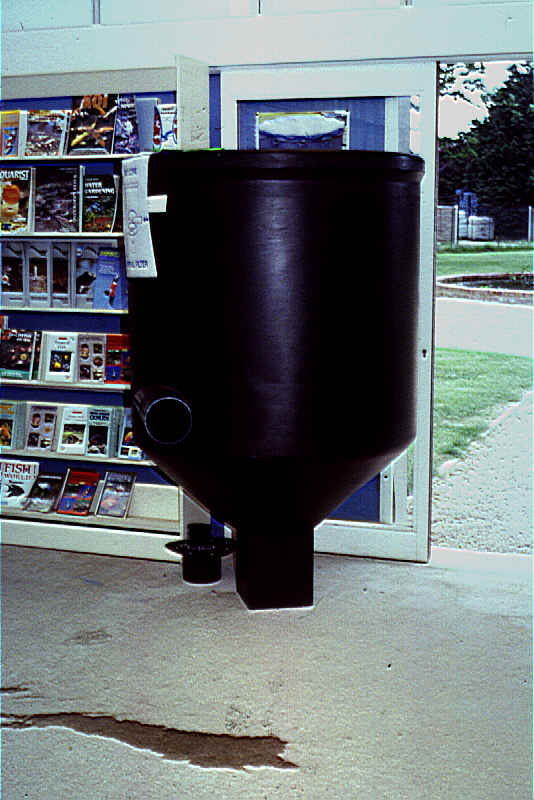 As mentioned earlier, Koi ponds lack water-purifying plants and must have a filtration system fitted to keep the water conditions at their best.
As mentioned earlier, Koi ponds lack water-purifying plants and must have a filtration system fitted to keep the water conditions at their best.
Koi are heavy feeders and produce a lot of waste, so the filtration system needs to be big enough to cope.
Filter units (at least as large as the one shown here) are sunk into the ground alongside the main pond and covered with decorative decking. The water enters the filter through a side port in the pond wall or by a bottom drain and associated pipework before being pumped back into the pond by an 'above surface' pump.
The filter shown is a 'vortex' type where water enters at a tangent and is whirled round with the dirt falling down the centre to the bottom from where it can be drained off.
Because oxygen is used up during the biological process, filtered water is re-oxygenated by means of a venturi device on its way back to the pond.
Site away from trees - too shady, possible problems with falling leaves, poisonous berries and liner-puncturing roots.
Ensure the pond will get full sunshine for most of the day, especially if you are looking forward to flowering Water-lilies.
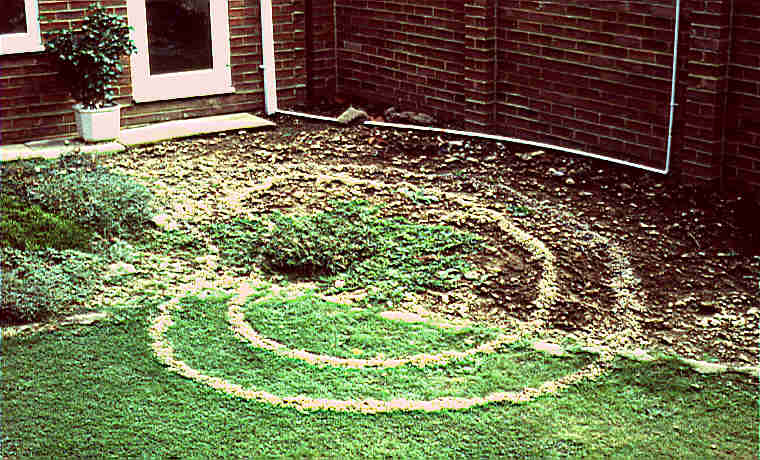 To get an idea how the pond will look (and fit in with your existing garden layout) draw its intended outline on the ground with sand, or a piece of rope, and view it from the house (even from upstairs) before starting to dig.
To get an idea how the pond will look (and fit in with your existing garden layout) draw its intended outline on the ground with sand, or a piece of rope, and view it from the house (even from upstairs) before starting to dig.
It's nice to be able to see the pond from the house as it's even interesting in wintertime.
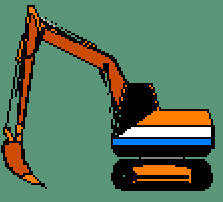 Always find out about any existing underground cables or pipes ahead of digging.
Always find out about any existing underground cables or pipes ahead of digging.
Whilst it is common practice to use excavated soil to build a rockery in which to hide the filtration system, make sure you have laid necessary electrical cables in buried plastic pipes to their destinations before you start piling up the soil!
Don't forget, various fish require different pond depths: refer to 'What Kind of Pond?' (above) for further details.
 A vital contribution to the pond's final appearance (no matter if it is made from a sheet liner or a pre-formed shell) is to make sure it is LEVEL. Throughout the digging out stage KEEP CHECKING THE LEVEL. Bridge the hole end to end and from side to side with a plank, long piece or wood - or even a ladder - and place a spirit level on top. Time taken at this stage will avoid disappointment later.
A vital contribution to the pond's final appearance (no matter if it is made from a sheet liner or a pre-formed shell) is to make sure it is LEVEL. Throughout the digging out stage KEEP CHECKING THE LEVEL. Bridge the hole end to end and from side to side with a plank, long piece or wood - or even a ladder - and place a spirit level on top. Time taken at this stage will avoid disappointment later.

When it comes to choosing fish for the planted pond, all varieties of single-tailed Goldfish - Common Goldfish, Shubunkins and Comets are suitable.
Twin-tailed varieties - Oranda, Lionhead, Veiltail, Moor, etc - are not hardy enough for year-round pond life although Fantails could be the exception.
In addition, there are a number of 'non Goldfish' species that are also highly-coloured which do well in the pond. These species include Golden Orfe, Bitterling, Red Shiners and Pumpkinseed, but be aware that many non-native species may now require a licence to be kept (details).
Do not be tempted to introduce any kind of Catfish into your pond as they will grow too large and prey on your other fishes.
 Koi are fine, providing you respect their need for space, high-quality water conditions - and their rapid growth rates!
Koi are fine, providing you respect their need for space, high-quality water conditions - and their rapid growth rates!
As their pond will not have any aquatic plants, the fish will show up better if the bottom and sides of the pond are dark-coloured.
Water clarity is most important, so any green water that develops must be removed (see Green Water Problems below) if you are to be able to see the fish throughout summer.
Aquatic plants provide a number of useful services in the pond.
Plant Water-lilies initially so that any existing leaves float on the water surface; stand the basket on an upturned bucket or bricks to achieve this; gradually lower the lily into deeper water as it grows.
Aim to cover around one-third of the pond's water surface with Water- lilies to provide shade and reduce algae problems. Marginal plants around the pond's circumference soften its edges and provide refuge for visiting animals and amphibians. Tall grassy types may blow over into the pond in windy weather so make sure their baskets are well anchored.
'Oxygenators' - around 2 clumps per square foot of water surface area - produce excess oxygen in the water during daylight but rampant growths can deplete oxygen levels during hot weather especially at night; provide extra aeration (leave the fountain on at night) to counteract this. Thin out oxygenators if necessary.
NEVER LOOK AT A LIT UV TUBE DIRECTLY.
In every case, the removal of affected algae is necessary before its decomposition depletes oxygen levels in the water. An effective remedy against green water is Tetra's AlgoRem.
Note that Green Water remedies are not necessarily effective against Blanketweed
There are many methods of dealing with Blanketweed: aquatic 'weedkillers' will kill it off but may set back other aquatic plants and you must still remove the dead blanketweed before it depletes the oxygen levels in the water.
Whatever steps one takes, it is always going to be a matter of control rather than elimination; most people fall back on pulling it out by hand - it makes a good mulch and compost!

They absorb nutrients from the water and will help keep the water clear; they provide spawning sites for fish and amphibians and, in the case of flowering species, they look nice too!
It is advisable not to put any soil on the pond's base but plant all aquatic plants in baskets which will keep them under easy control.
DEALING WITH GREEN WATER & BLANKETWEED PROBLEMS
Green water forms as soon as the springtime sunshine falls on to the water. Millions of minute green cells feed on nutrients which have built up over winter in the pond from decaying vegetation - a good reason to 'Spring-clean' the pond each autumn.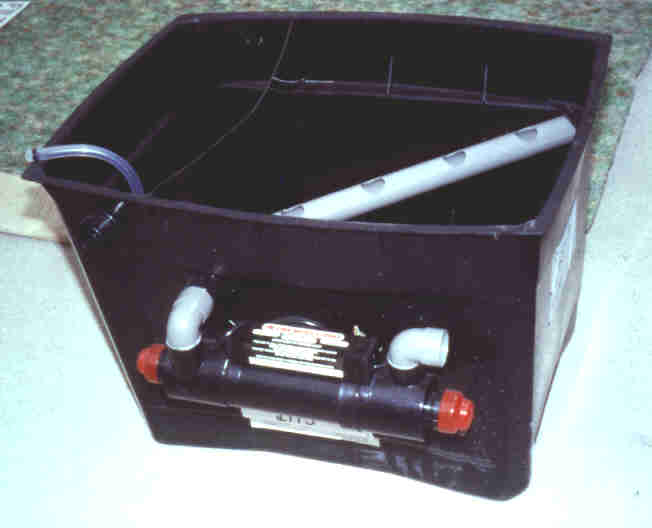 Unfortunately no filter medium is dense enough to strain out the microscopic green cells and still let water through, but the use of an Ultra-violet Lamp (UV) in conjunction with a filter can clear green water quite easily. As the green water passes by the UV tube, the radiation will cause the cells to die and clump together in sufficiently large lumps which the filter system can then remove. Renew the UV tube every year and keep the surrounding quartz glass tube clear of debris so that the lamp works to its ultimate efficiency.
Unfortunately no filter medium is dense enough to strain out the microscopic green cells and still let water through, but the use of an Ultra-violet Lamp (UV) in conjunction with a filter can clear green water quite easily. As the green water passes by the UV tube, the radiation will cause the cells to die and clump together in sufficiently large lumps which the filter system can then remove. Renew the UV tube every year and keep the surrounding quartz glass tube clear of debris so that the lamp works to its ultimate efficiency.
ALWAYS SWITCH OFF THE UNIT BEFORE PERFORMING ANY MAINTENANCE TASK.
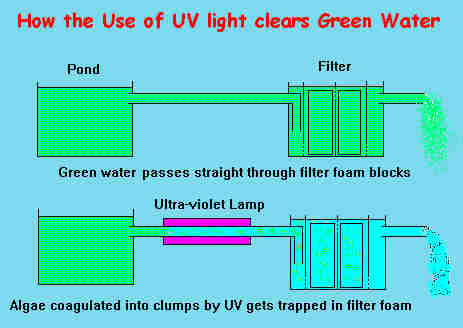
There are other methods of dealing with green water, most of which entail causing the algae to sink to the pond floor or float to the surface in mats. 
Interpet's 'Pond Balance', Tetra's 'AlgoFin' and Laguna's Phos X are proven remedies, all safe to use with fish and plants. The ubiquitous 'barley straw' treatment appears to work but it is not always a predictable success in differing water qualities or from one area to another.
Pond volume = Surface area (length x width) x depth.
For Imperial, use dimensions in feet and multiply result by 6.25 for gallons
For Metric, use cm dimensions and divide result by 1000 for litres
(1 gallon = 4.54 litres)
For an illustrated guide to calculating volumes of ponds of various shapes go to
Pond Calculations
DO NOT OVERFEED - excess, uneaten or undigested food will pollute the water.
The onset of winter brings a different set of rules for the pond.

STOP FEEDING fish when water temperature is regularly below 10oC (50oF).
When temperatures are restored to 100C (50oF) or above consistently, feed easily-digested 'wheatgerm-based' foods at first, gradually changing over to the main diet; as autumn approaches and temperatures fall, again use 'wheatgerm-based' foods as a final diet before feeding ceases for the winter.
A complete covering of ice over the pond can trap dangerous gases over the water surface. You can maintain an open area of water by means of a floating 'igloo' device which creates a patch of warm air and keeps part of the water surface open.
If you turn off filters over winter, remember they will take some weeks to re-establish their full efficiency when re-started.
Most major aquatic manufacturers have helplines; there are a number of specialist magazines published each month. You can also find extra help at your local Aquarist Society.